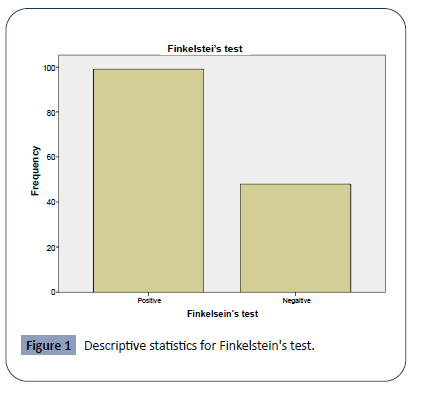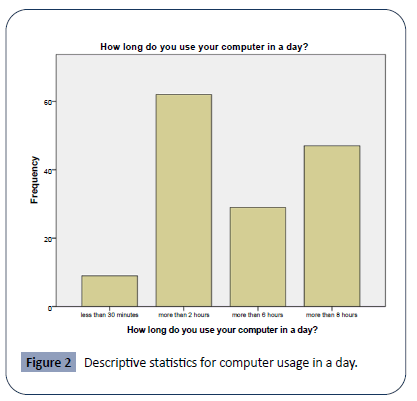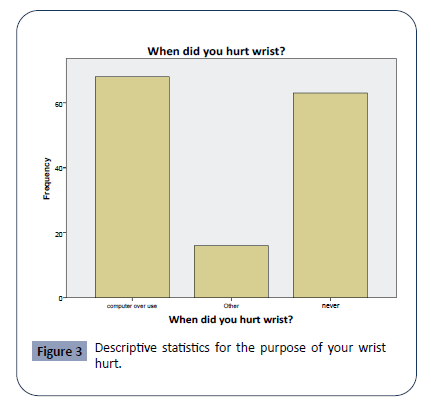Layba Awais1, Syed Ali Behram Subawari1*, Shehryar Azam2 and Israa Anwar3
1The University of Lahore, Lahore, Pakistan
2Bakhtawar Amin College of Rehabilitation Sciences, Multan, Pakistan
3College of Rehabilitation Sciences, Riphah University Lahore Campus, Lahore, Pakistan
- *Corresponding Author:
- Syed Ali Behram Subawari
The University of Lahore, Pakistan
Tel: +923346035054
E-mail:themedresearcher@gmail.com
Received Date: March 09, 2020; Accepted Date: March 27, 2020; Published Date: April 02, 2020
Citation: Awais L, Subawari SAB, Azam S, Anwar I (2020) Incidence of De Quervain’s Tenosynovitis in Computer Operators. Health Sci J. 14 No. 2: 705.
DOI: 10.36648/1791-809X.14.2.705
Keywords
De quervain’s tenosynovitis; Finkelstein’s test; Prevalence; Wrist pain
Introduction
De Quervain’s syndrome is a stenosing tenosynovitis of the first extensor compartment containing abductor pollicis longus and extensor pollicis brevis. Pain is felt over those tendons at the radial border of the wrist, mainly with thumb and along with wrist movements. Pain near the base of your thumb and swelling at the base of thumb occurs. Due to this condition difficulty moving your thumb and wrist occurs when you are doing some activity involving grasping and piching. A sticking or Stop and go sensation may be felt in your thumb when you are moving it. Finkelstein’s test checks passive adduction of the thumb into the palm and ulnar deviation of the wrist will typically exacerbate signs. If this condition goes too long without treatment, the pain may spread to back of your forearm or both. Pinching, grasping and their movements of thumb and wrist aggravate the pain. Untreated de Quervain tenosynovitis may make it hard to use your effected side hand and it may limit the wrist range of motions. Injection therapy may be diagnostic and therapeutic [1]. In 1895, de Quervain posted a document of five instances of what he called as continual tenovaginitis arising in the first dorsal compartment of the wrist. This now eponymous circumstance has due to the fact that been established as an essential motive of pain at the radial border of the wrist. Despite great interest within the circumstance, its etiology and pathology stay difficult to understand. Many authors recall de Quervain's disease to be a stenosing tenovaginitis with either an acute or persistent inflammatory etiology. Others describe an aggregate of inflammation and degeneration [2]. De Quervain's tenosynovitis impacts thumb tendons. These tendons are the abductor pollicis longus and extensor pollicis brevis on their manner to the thumb, the APL and EPB tendons travel by means of side alongside the interior edge of the wrist. They bypass via a tunnel close to the stop of the radius bone of the forearm. This tunnel is coated with a slippery coating called tenosynovium. The tenosynovium is a slippery protecting that permits the two tendons to glide easily to and fro as they circulate the thumb. Inflammation of the tenosynovium and tendon is known as tenosynovitis. In de Quervain's tenosynovitis, the inflammation constricts the motion of the tendons within the tunnel [3].
Stenosing tenovaginitis of the abductor pollicis longus (APL) and extensor pollicis brevis (EPB) within the first extensor compartment of the wrist has been known on account that De Quervain suggested the situation in 1895. Standard anatomy texts describe two tendons (APB and EPB) in one compartment. Many cadaveric research were published and it's been mentioned that APL and EPB may be in two separate compartments [4]. This condition is more common in females than in males. The prognosis is scientific and is most intently correlated with a positive Finkelstein test or Eichoff maneuver. Radiographs can be indicated to rule out other wrist pathologies; however, they normally are not endorsed within the evaluation of classically provided de Quervain disease [5]. The anticipated prevalence of de Quervain tenosynovitis is set 0.5% in males and 1.3% in females with top occurrence among those of their forties and fifties. It may be visible more commonly in individuals with a record of medial or lateral epicondylitis. Bilateral involvement is frequently mentioned in new mothers or baby care vendors in whom spontaneous decision resolution occurs as soon as lifting of the child is less common [6]. As the researches regarding De Quervains Tenosynovitis are in thousands but a very few have been done in Pakistan where the environmental factors and job descriptions vary as compared to that of other countries. The aim of this study is to investigate the incidence of De Quervain’s Tenosynovitis in regular computer operators.
Material and Methods
Each participating person among the 147 regular computer operators was examined for the Finkelstein’s Test in order to diagnose the De Quervain’s tenosynovitis. Along with this a wrist pain questionnaire was asked to be filled in order to check the prevalence of wrist pain in regular computer operators. Pain in radial side of wrist, tenderness of first dorsal compartment and positive Finkelstein’s Test used to define Dequervain’s tenosynovitis. People included are with pain score of 4 or higher on visual analog scale (VAS). Following exclusion criteria, people with immobilization of hand more than 3 weeks. And people having any cervical discogenic issue or radiating pain to wrist. People with fractured wrist, any previous trauma or injury to wrist or upper limb surgery were excluded.
Results
Among 147 regular computer operators there were 74 (50.3%) males and 73 (49.7%) females with a mean age of 22.44 ± 1.81 years. The minimum age was 19 years and maximum was 29 years.
Among all the regular computer operators 99 (67.3%) showed the Finkelstein’s test positive whereas 48 (32.7%) showed the pain in Finkelstein’s test as being negative (Figure 1).

Figure 1: Descriptive statistics for Finkelstein's test.
Among 147 participating computer operators, 9 (6.1%) used computer for less than 30 minutes in a day. 62 (42.2%) used computer for more than 2 hours in a day. 29 (19.7%) used computer for more than 6 hours in a day. 47(32.0%) used computer for more than 8 hours in a day (Figure 2).

Figure 2: Descriptive statistics for computer usage in a day.
Among 147 participating computer operators, 68(46.3%) hurt their wrist by computer overuse, 16 (10.9%) hurt their wrist by other activities, 63 (42.9%) never got their wrists hurt (Figure 3).

Figure 3: Descriptive statistics for the purpose of your wrist hurt.
Among 147 participating computer operators ,9 (6.1%) claimed that driving worsened the pain,62 (42.2%) claimed that typing made the pain worst, 3 (2.0%) claimed that sleeping made the pain worst, 5(3.4%) claimed that exercise made the pain worst, 5 (3.4%) stated that pain got worse due to twisting, 9 (6.1%) stated that lifting lead to worsening of pain,16 (10.9%) stated that their pain got worse after repetitive use, 1(0.7%) stated pain getting worse due to grasping, 2 (1.4%) stated that the pain got worse due to throwing,35 (23.8%) revealed that none of the activities made their wrist painful (Table 1).
Table 1 Descriptive statistics for the activities that make the pain worse.
| |
Frequency |
Percent |
| Driving |
9 |
6.1 |
| Typing |
62 |
42.2 |
| Sleeping |
3 |
2.0 |
| Exercise |
5 |
3.4 |
| Twisting |
5 |
3.4 |
| Lifting |
9 |
6.1 |
| Repetitive Use |
16 |
10.9 |
| Grasping |
1 |
0.7 |
| Throwing |
2 |
1.4 |
| None |
35 |
23.8 |
| Total |
147 |
100.0 |
Discussion
The present research shows that among 147 computer operators tested for De Quervain’s tennosynovitis by Finkelstien’s test 99(67.3%) showed the test as being positive and 48 (32.7%) showed the test as being negative whereas Hingarajia et al. conducted a research that stated that the prevelance of De Quervian’s tenosynovitis was 46% in mobile users. Kumar et al. [1] stated isolated cases of pain in the thumb have been reported but this study noted changes both clinically and by ultrasound in the tendons of the thumb. These changes should be taken as warning signs of possible subclinical changes taking place in the soft tissues of the thumb in these subjects due to repetitive use of mobile phones and thus, making them prone for developing painful Musculoskeletal disorders [7]. Among 147 participating computer operators ,62 (42.2%) claimed that typing made the pain worst. Similarly Ali et al. conducted a research that stated result of the study concluded that students experienced pain and weakness over the base of the thumb/wrist which shows the De Quervain’s positive in that students and there is a positive association between the thumb pain and frequent text messaging [8].
Ali et al. conducted a research that stated almost half of the students use their mobile phones for texting more than 50 SMS per day. Similarly in the present research, among 147 regular computer operators 62 (42.2%) used computer for more than 2 hours in a day. 29 (19.7%) used computer for more than 6 hours in a day. 47 (32.0%) used computer for more than 8 hours in a day resulting in high amount of people being diagnosed with De Quervains Tenosynovitis [8].
Conclusion
It is concluded that the incidence of De Quervains Tenosynovitis among the regular computer operators on the basis of Finkelstien Test was high. Many of the regular computer operators used computer for more than 2 hours up to more than 8 hours a day. Also the keyboard typing made the pain worst among the regular computer users.
26661
References
- Hingarajia D, Patel D, Desai H, Dora V (2018) Prevalence of de quervain’s tenosynovitis and its effect on pinch strength in mobile users. Int J Recent Sci Res 9: 25032-25035.
- Clarke M, Lyall H, Grant J, Matthewson M (1998) The histopathology of de Quervain’s disease. Journal of Hand Surgery 23: 732-734.
- (2020) de Quervain's Tenosynovitis. American Academy of Family Physicians.
- Bahm J, Szabo Z, Foucher G (1995) The anatomy of de Quervain's disease. International orthopaedics 19: 209-211.
- Ilyas AM, Ast M, Schaffer AA, Thoder J (2007) De quervain tenosynovitis of the wrist. JAAOS-Journal of the American Academy of Orthopaedic Surgeons 15: 757-764.
- Eapen C, Kumar B, Bhat AK, Venugopal A (2014) Extensor pollicis longus injury in addition to De Quervain’s with text messaging on mobile phones. J Clin Diagn Res 8: LC01-C04.
- Ali M, Asim M, Danish SH, Ahmad F, Iqbal A, et al. (2014) Frequency of De Quervain’s tenosynovitis and its association with SMS texting. Muscles Ligaments Tendons J 4: 74-78.








